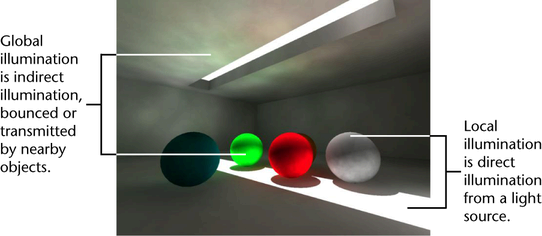
Indirect light is all the inter-reflected light in a scene. Global illumination is an approximation of real-world indirect light transmission.
With global illumination, the contribution of bounced light from other surfaces in the scene is used to calculate the overall light contribution and the color values at points on objects that are not directly illuminated (that is, at points that do not receive light directly from a light source, such as a spot light).
Global illumination occurs when light is reflected off of or transmitted through an opaque (reflection only), transparent or semi-transparent surface (see Diffuse, Specular, and Glossy refraction of light) from a surface to bounce off or be absorbed by another surface.
Local illumination is only the light provided directly from a light source (such as a spot light).
Direct light is emitted from a light source and travels in a straight path to the illuminated point (either on a surface or in a volume).
With direct illumination only each light source's contribution is used to calculate the overall light contribution to any given illuminated point.
 Except where otherwise noted, this work is licensed under a Creative Commons Attribution-NonCommercial-ShareAlike 3.0 Unported License
Except where otherwise noted, this work is licensed under a Creative Commons Attribution-NonCommercial-ShareAlike 3.0 Unported License